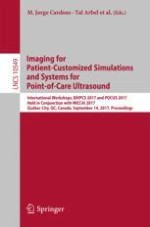2017 | Buch
Imaging for Patient-Customized Simulations and Systems for Point-of-Care Ultrasound
International Workshops, BIVPCS 2017 and POCUS 2017, Held in Conjunction with MICCAI 2017, Québec City, QC, Canada, September 14, 2017, Proceedings
herausgegeben von: M. Jorge Cardoso, Tal Arbel, Prof. Dr. João Manuel R.S. Tavares, Stephen Aylward, Prof. Dr. Shuo Li, Emad Boctor, Dr. Gabor Fichtinger, Prof. Kevin Cleary, Bradley Freeman, Luv Kohli, Deborah Shipley Kane, Matt Oetgen, Sonja Pujol
Verlag: Springer International Publishing
Buchreihe : Lecture Notes in Computer Science
